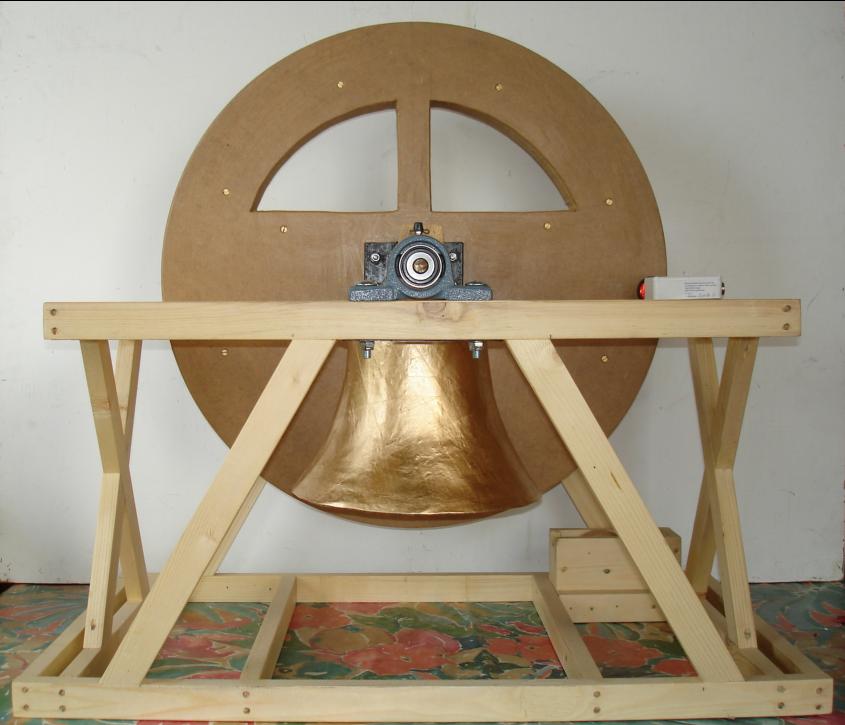

Mini-dumbbell, John Norris design,
in production since 2003.
A home dumbbell connected to ringing software on a PC to form a ringing simulator is an excellent aid to real ringing in the tower. It’s ideal for practising new methods and developing your listening skills and ringing by rhythm.
It’s also challenging, very satisfying when you ‘get it right ’, and even fun.
Ring whatever method you want, whenever you want, on as many bells as you want, without being dependent on the availability or skills of other ringers.
A dumbbell in the home has one outstanding advantage – it is always available,
Not every home or garage loft has sufficient space and structural strength for a large and heavily weighted wheel but most homes can accommodate a mini-dumbbell, like the example shown above.
Ringing it is easy. It feels and handles just like a bell in a mini-ring and mastering the technique takes only a few minutes, even for a non ringer.The design shown uses an MDF wheel, approx. 23" in diameter and 2" thick. The weighted wheel weighs approx. 18 lb, (5 lb for the upper half of the wheel with pierced quadrants; 7 lb for the lower half, plus 6 lb of attached steel weights). The wheel is mounted on a headstock in a wooden frame approx. 29" long and 17" wide, the overall height being 27". A ½" spindle through the headstock runs in self-aligning ball bearings and a papier maché bell is fitted to the headstock. The whole ensemble, including the papier mache ‘bell ’, loosely represents a bell in a traditional frame and the ‘feel ’ is similar to a 10 lb bell in a mini-ring.
[If desired, the papier mache bell can be replaced by a real bell, up to 10" in diameter.]
Unlike a churchbell, there is no need for a stay and slider.
A stay and pendulum slider, using an adjustable cord to control the angle of set, can be provided but it requires great precision in bell handling and its use is not recommended.

The dumbbell is supplied complete with rope (non-standard sally colours available), ceiling boss, sensor and connecting cable.
For further information, or if you fancy building one yourself, see the downloadable DIY Instructions (9Mb)
To accommodate a mini-dumbbell to the above design, you need space not less than 29" (750mm) long, 17" (450mm) wide and 27" (700mm) high, plus a little extra to allow for access, and with sufficient headroom to stand beneath.
The loft hatch aperture needs to be not less than 600mm x 450mm
The recommended mounting position is in the loft, with the rope falling through a ceiling boss to a ringing position on the landing beneath.
[Reservations are sometimes expressed by potential purchasers about the need to cut a 2" dia. hole in the
ceiling for the rope. Given the size of hole represented by a typical loft hatch, the small hole needed for the rope seems almost immaterial.
However, there may be alternatives, depending on the size of the hatch:-
For example:
Mount the dumbbell with the long wheel side, suitably supported, over the edge of the hatch.
Mount the dumbbell with the short, pulley end, of the frame over the edge of the hatch.
Mount the dumbbell wholly over the trap, either on a trolley on rails or on a short tower, allowing the rope to fall through the hatch while preserving access to the loft.
Mount the dumbbell over the stairwell.
Mount the dumbbell on a tower in a spare room.]
Portable Tower
If the dumbbell is to be used for demonstration purposes a portable tower may be required.
See downloadable Instructions for a design for building your own tower (6Mb).
The dumbbell needs to be fitted with a sensor which will send a signal to the computer at the appropriate point in the dumbbell’s swing. Several types are possible including optical, induction and Hall effect and information on all three types is given below for the sake of completeness. However, the Hall effect sensor is currently the type normally offered with the dumbbell.
Hall effect sensor:-
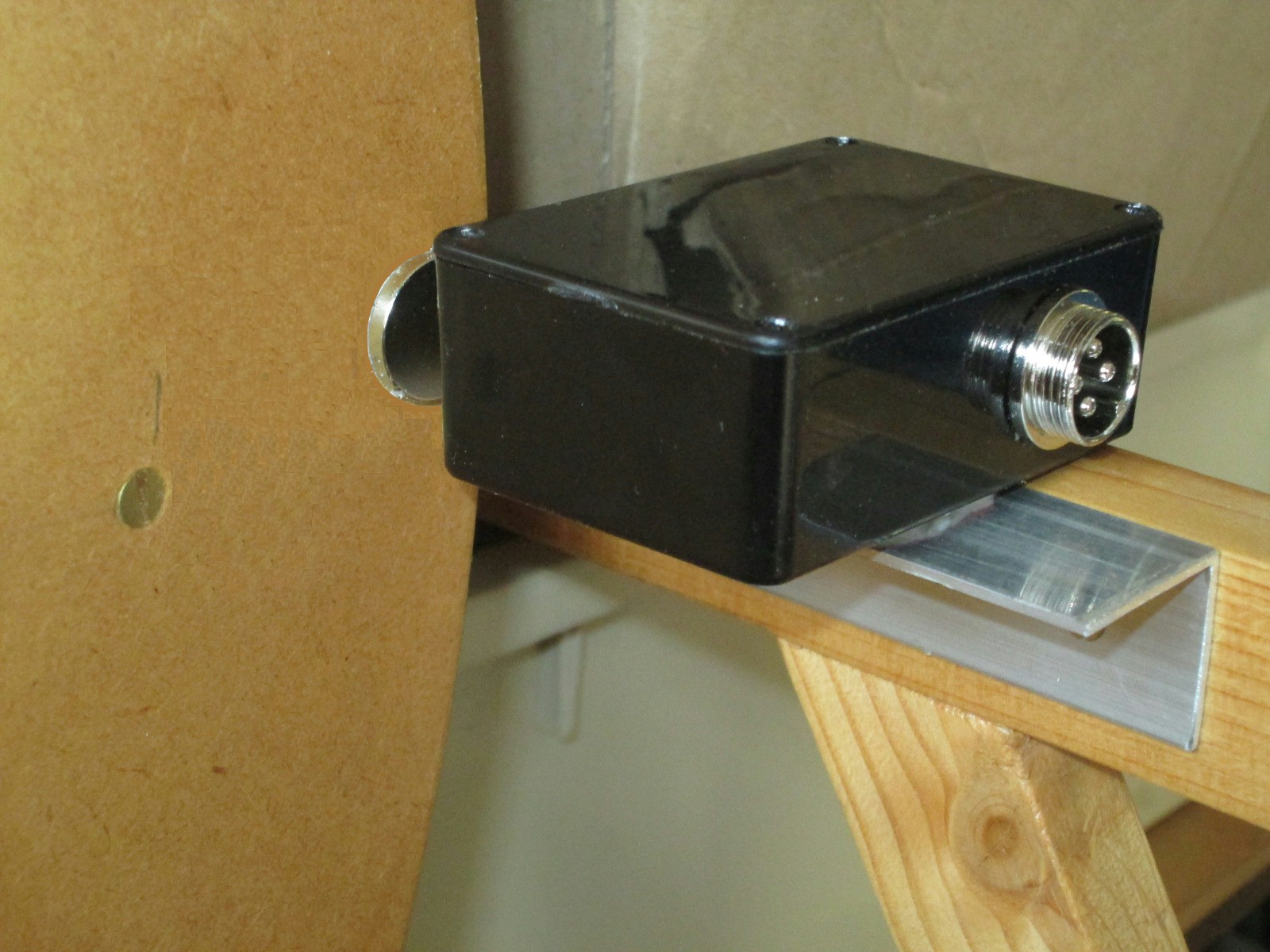
Named after its discoverer, Edwin Hall in 1879, the Hall effect is the production of a transverse voltage across a current carrying conductor in the presence of a magnetic field. The Hall effect sensor supplied with the dumbbell, made to a design by Derek Livsey adapted by Alan Griffin to increase its range of application, is housed in a small box, 75mm x 50mm x 25mm, mounted on the dumbbell frame. A magnet attached to the wheel passes the sensor as the mock bell passes bottom dead centre and the momentary voltage produced is passed to the computer.
Induction type sensor:-
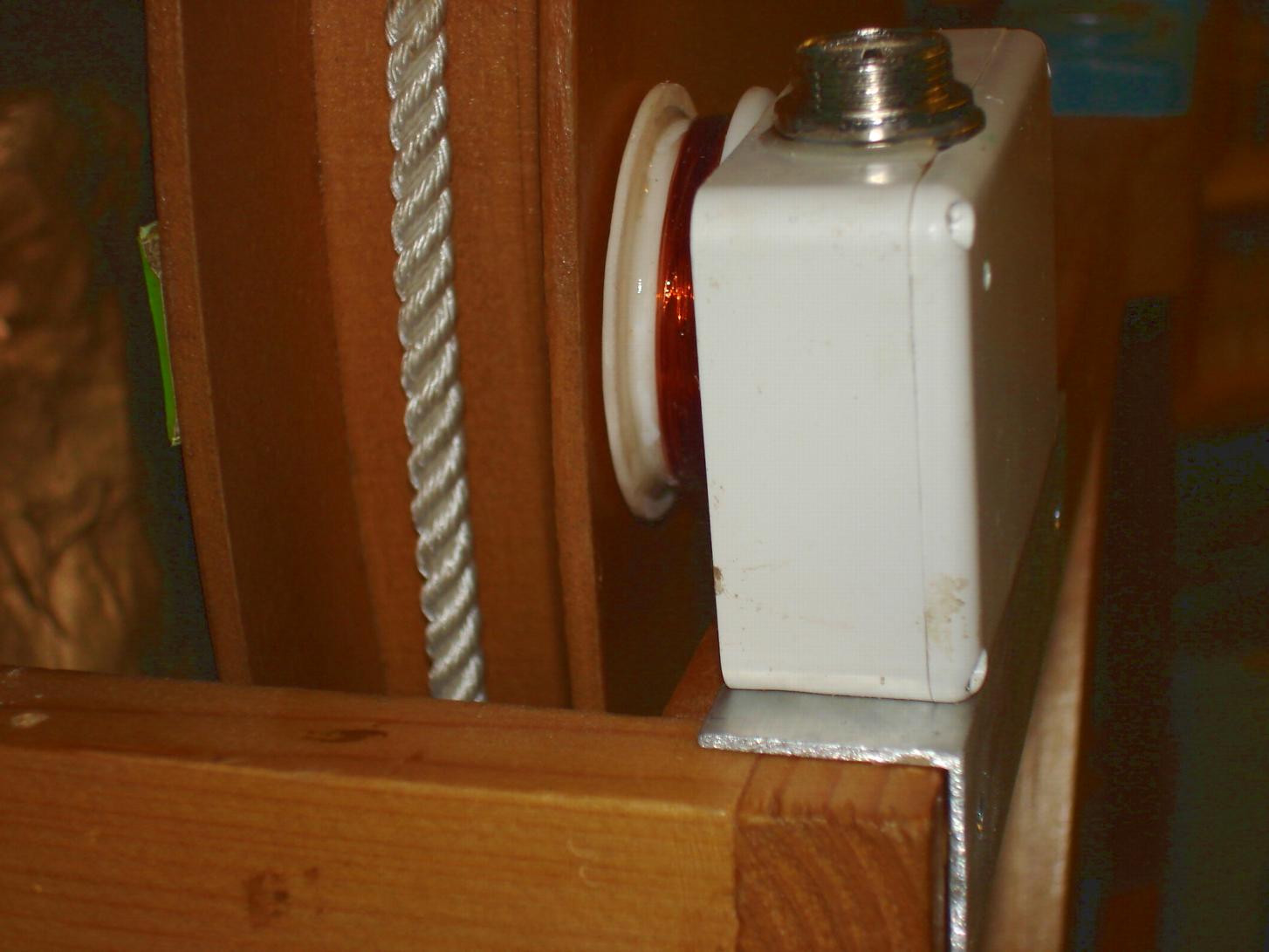
The induction type proximity sensor, made to a design by Aidan Hedley, works like a metal detector. The actual sensor is contained in a small box, 75mm x 50mm x 25mm, mounted on the dumbbell frame. A tuned activator coil attached to the wheel passes a matching reactor coil in the sensor as the mock bell passes bottom dead centre. The oscillator in the sensor responds and a brief output ‘pulse’ is passed via the interface to the computer. The induction sensor has the advantage, Compared with the optical sensor, that it is unaffected by ambient lighting level and so is more suitable if the dumbbell is likely to be used outdoors or in bright artificial lighting.
Optical sensor:-
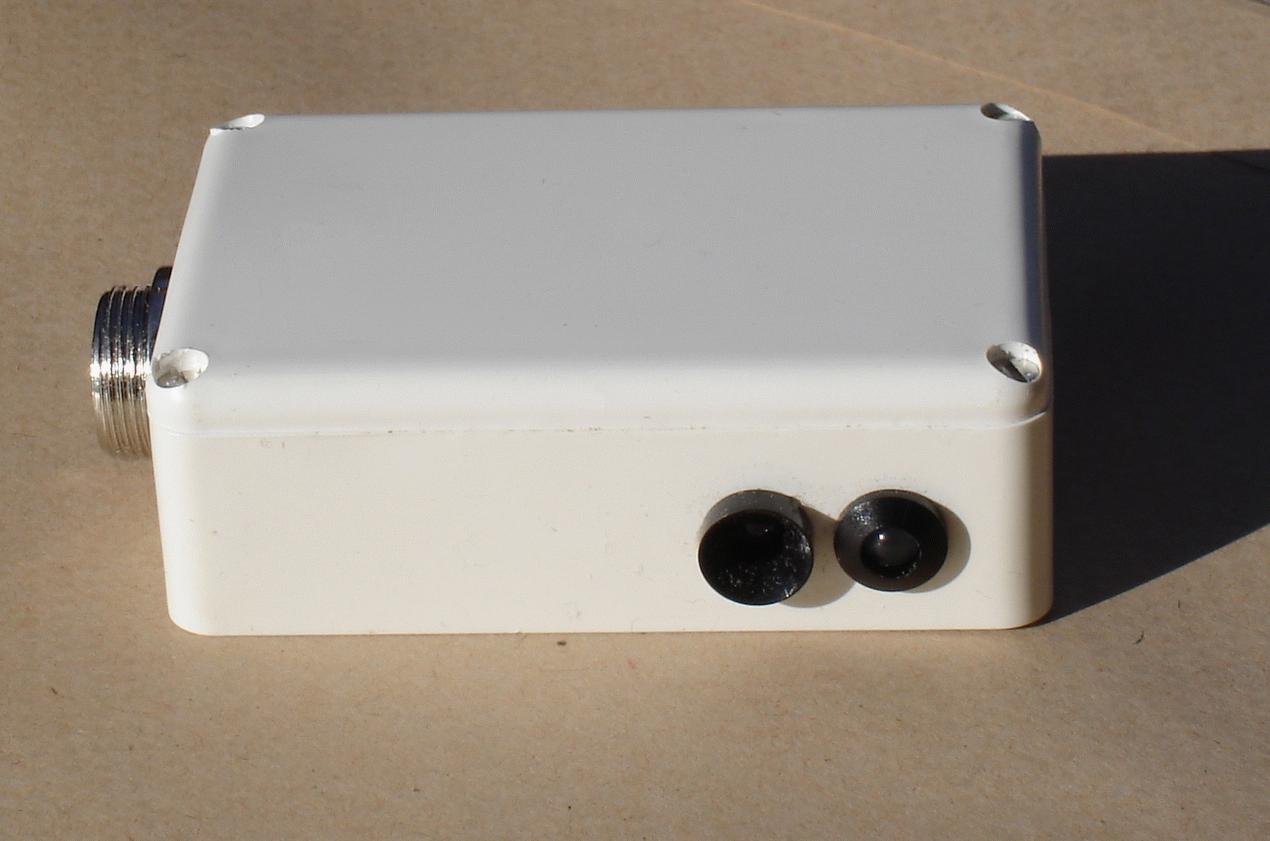
The optical sensor, in this case an Alan Griffin design, is contained in a small box, 75mm x 50mm x 25mm, mounted on the dumbbell frame. A light source in the sensor projects a beam towards the wheel and a reflector strip on the wheel reflects the beam as the mock bell passes BDC. A photo transistor in the sensor detects the reflected light and the brief output ‘pulse’ is passed to the computer.
[For DIY enthusiasts, constructional details of the ‘budget’ version of Alan Griffin’s combined sensor and interface are downloadable in two pages here:- Page 1 and Page 2. This is electronically identical to the version available for purchase, illustrated above, but is housed in a film canister with a non-detachable lead.]
(a) Windows PC
The computer can be a standard WindowsPC running Abel, Beltower or Ringing Master.
Any PC running Windows98 or later is likely to be adequate but visit the software websites for details of minimum spec.
All three sensor types are intended for cable connection to a PC via a serial port. If using a PC not equipped with a serial port, a serial to USB converter will be required, available from Maplin and other suppliers at £20 or less. If using Windows7, make sure that the converter comes with a Windows7 driver.
The sensors require a delay between the moment when the signal is sent to the computer - as the mock bell passes BDC - and the normal striking point. This delay can be applied in software and Abel, Beltower and Ringing Master all include provision for this.
Alternative designs such as David Bagley’s optical sensor and single bell interface (SBI) provide the delay in the interface. For further information visit David Bagley’s website www.ringing.demon.co.uk. The end result is the same.
(b) RISC OS Alternative
For RISC OS enthusiasts the dumbbell can be connected to an Acorn RiscPC or A7000 running the author’s ringing program Stringing.
![]() The dumbbell can now also be connected to Stringing on a Raspberry Pi.
The dumbbell can now also be connected to Stringing on a Raspberry Pi.
Stringing does not provide a delay facility and a Griffin RISC OS interface is needed to provide the delay in hardware. Details of Alan Griffin’s RISC OS interface can be found in in the Stringing Manual (750Kb). For a RiscPC or A7000 a Watford I/O card will also be needed. This can be purchased from CJE Micro’s. Raspberry Pi has a built-in I/O connector.
(Stringing will appeal to RISC OS enthusiasts and may be the program of choice if a suitable Acorn computer is to hand. However, it does not offer such a wide range of features as Abel, Beltower and Ringing Master.)
Manufacture will not continue indefinitely and availability is not guaranteed.
For further information about costs and availability, enquire for details or telephone 07774 863184.
Ringing dumbbells can be made in different sizes.
A full-sized dumbbell, i.e. with a wheel similar in diameter to a typical church bell wheel, is rung exactly like a church bell. Being slightly more ‘docile’ than a real bell it can be particularly useful for teaching bell handling. However, a dumbbell with a full size wheel, typically 4ft. in diameter, may pose significant space and stress issues for the average home. For details of such a dumbbell visit www.saxsim.com.
For details of an ingenious alternative design, using counter-rotating weighted wheels to give ‘real bell’ feel with minimal stress on the supporting structure, visit http://jaharrison.me.uk/Ringing/DumbBell
The original dumbbell was a windlass-like piece of exercise apparatus in which, for successive pulls of the rope, a roller with weighted arms rotated first in one direction and then in the other. The ‘feel’ was rather different from a church bell hung for ringing but nevertheless there was a strong similarity with full circle ringing in the English style, in which for each pull of the rope a bell turns ‘full circle’ from approximately upside down to approximately upside down, rotating in one direction at one stroke and the other at the next.*
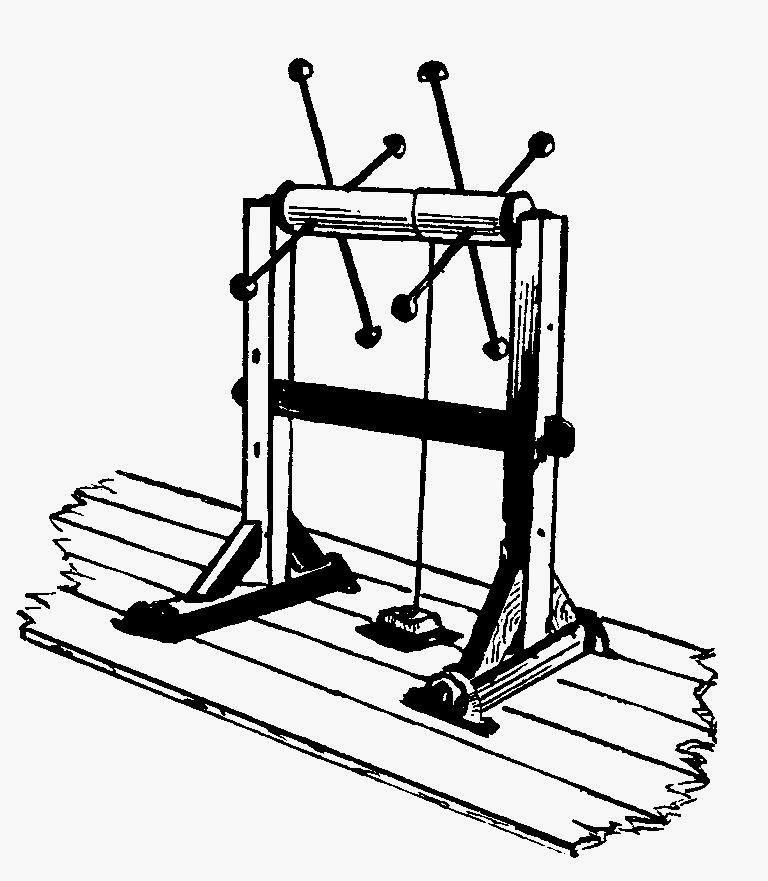
17th century dumbbell at Knole House, Kent
(drawing on p.58 of History and Art of Change Ringing, Ernest Morris)
The hand-held dumbbell used in weight training is believed to get its name from its resemblance to the weighted arms attached to the roller.
* Correspondence in The Ringing World in December 2010 touched on the degree of similarity between ringing a dumbbell of the historic Knole type, comprising a roller with weighted arms, and ringing an actual bell. It was noted that:-
“The operation and dynamics were somewhat different from a bell. It has no wheel, and the (relatively light) weights are counter-balanced. The rope winds around a shaft that is several inches in diameter, not several feet as in a bell wheel, so the shaft must rotate many times to achieve a realistic vertical rope movement.
With the weights more or less balanced, the dumbbell will not swing spontaneously from one stroke to the other like a bell, though the weight of the rope would gradually accelerate it, providing the bearings aren’t too stiff. There would be no difference between handstroke and backstroke either. The ringer, rather than gravity, would need to provide most of the energy to make it turn, and applying less effort would lead to it turning more slowly. So it would feel very different from ringing a bell.”
To put this to the test a modern mini-dumbbell of the type described above was modified by removing the weighted wheel and fitting a 3" diameter roller with weighted arms in the manner of the C17 example at Knole depicted above. Ringing the weighted-roller type dumbbell proved much closer, in the view of those trying it, to ringing a real bell of similar notional size than might be expected. The roller dumbbell is certainly harder work - as befits its use as an exercise apparatus - and the speed of rotation is more dependent on the degree of pulling and checking applied by the ringer. However, the ‘feel’ is surprisingly similar to a real bell. If a rope with sally is fitted it is not only easy to ring it with alternate handstroke and backstroke in the usual manner but it comes naturally to do so.
You can download a movie clip comparing a Knole type roller dumbbell with a ‘bell’ in the Wickham Ring. (The noise is from the turning of the slightly irregular roller, not the dumbbell in the Ring).